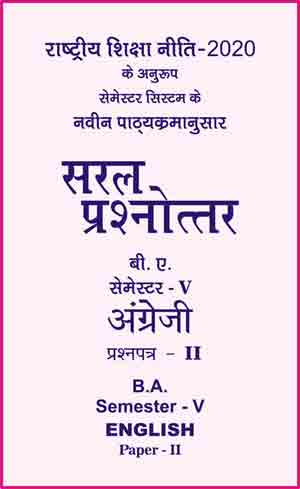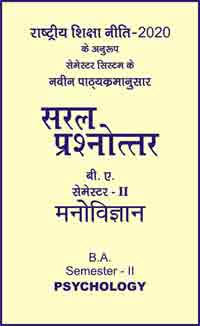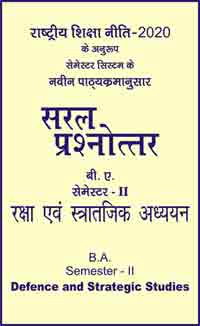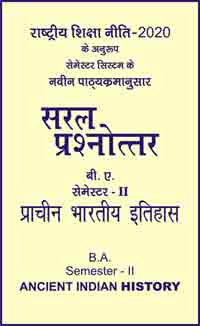|
बी ए - एम ए >> बीए सेमेस्टर-5 पेपर-2 अंग्रेजी बीए सेमेस्टर-5 पेपर-2 अंग्रेजीसरल प्रश्नोत्तर समूह
|
5 पाठक हैं |
|||||||
बीए सेमेस्टर-5 पेपर-2 अंग्रेजी - सरल प्रश्नोत्तर
Question- Discuss the development of Tom Joad as a character. How does he grow throughout the book? What effects do Jim Casy's imprisonment and death have on his development?
Answer-
Tom Joad undergoes a significant transformation over the course of the novel. Early on the reader learns that Tom spent four years in jail for homicide. Released on parole, he hitchhikes home to his family. Tom unashamedly tells the man he rides with what he had done: "Means I killed a guy. Seven years. I'm sprung in four for keepin' my nose clean". Tom also meets Jim Casy, a former preacher, during his journey homewards. When his past is brought up in conversation with Casy, Tom speaks of the crime he committed very similarly to the way he had described it to the driver he hitchhiked with. "I'd do what I done again... I killed a guy in a fight. We was drunk at a dance. He got a knife in me, an' I killed him with a shovel that was layin' there". Tom's lack of remorse is justified in that it was self-defense. But it is his inability to be ashamed or reflective at all that is indicative of someone who lives only in the present. His desire to avoid looking too deeply into the past or future is shown in his response to a question of Casy's concerning the number of jobs available in California: "How'd I know? I'm jus? puttin' one foot in front a the other... This here little piece of iron an' babbitt. See it? Ya see it? Well, that the only goddamn thing in the world I got on my mind". Tom later breaks his parole to travel west with his family. This action also shows his disregard for any future consequences.
Jim Casy is the reverse of Tom Joad's initial characterization. While Tom concerns himself only with the now, Casy constantly looks towards the future, often puzzling over the state of humanity and divinity. Casy's overall thoughtfulness is illustrated well by a theological theory of his: "Maybe it's all men an' all women we love; maybe that's the Holy Sperit the human sperit the whole shebang. Maybe all men got one big soul ever'body's a part of". But his tendency for future thought is not what separates him from Tom. It is his moral character and selflessness that distinguishes him from any other person in the novel. When Tom gets into an altercation with a deputy, Casy takes the blame, telling an officer that he had "knocked out your man there". This brief moment shows the difference between the men well. Tom, giving into a moment of passion, does not think of the consequences his possible arrest would have on his family or himself. Casy, on the other hand, realizes the gravity of the situation immediately. He understands Tom's importance to his- family: "Somebody got to take the blame. I got no kids. They'll jus' put me in jail, an' I ain't doin' nothin' but set aroun"". Casy's morality and concern for the future contrasts heavily with the early characterization of Tom Joad.
Tom Joad's interactions with Jim Casy are vital in understanding his change as a character. Towards the beginning of the story, Tom is shown to care only for his family and the people in his immediate surroundings. But his way of thinking changes drastically by the end of the story. He sheds this day by day philosophy and gains a new sense of purpose: the betterment of the lives of the western migrants. Tom tells his mother that he'll "be ever'where wherever you look. Wherever they's a fight so hungry people can eat, I'll be there. Wherever they's a cop beatin' up a guy, I'll be there".
This change was brought about by the teachings of Casy. Casy, during his time in jail, learns about the power of mobilization of popular support. With this realization, he begins to organize migrants workers for a wage protest. Tom later stumbles into Casy and his band of men, where he learns about Casy's time in jail. "Well, one day they give us some beans that was sour. One fella started yellin', an' nothin' happened... Then another fella yelled... By God! Then sompin happened! They come a-runnin', and they give us some other stuff to eat". After their brief conversation, the men spot flashlight beams, and two policemen approach them, recognizing Casy as the workers' leader. Casy protests that the men "don' know what you're doin'. You're helpin' to starve kids". In the middle of his protest, one of the policemen sinks a pick handle into Casy's skull, killing him instantly. This moment serves as the catalyst for Tom's change from content bystander to activist.
After Casy is attacked, Tom retaliates and kills one of the policeman. The killing of a police officer, although immoral, is still a far cry from the drunken murder that had landed him in prison four years earlier. Here, by standing up for the rights of the western migrants, he begins to fight for a cause far greater than just himself or his family. In effect, Tom is taking Casy's place. Surely, his methods are different (he is far more confrontational and unpredictable), but he is now fighting for the same goal as Casy: equality for the suffering laborers. Tom even ascribes his change in character to Casy himself: "God, I'm talkin' like Casy. Comes of thinkin' about him so much. Seems like I can see him sometimes". And when his mother asks him what he plans to do with himself, Tom replies that he will do "what Casy done". At this point, Tom's characterization has taken a complete 180. He is prepared to take Casy's place and fight for better conditions, not only for his own family, but for all other migrant families in California.
|
|||||
- Question- Discuss in detail the development of English novel from the eighteenth century to the Modern Age.
- Question- What do you understand by Novel? What are the elements which are to considered in plot construction.
- Question- Write a note on characterization of a novel. How much is it important for development of a novel?
- Question- Write a short note on narrative technique of a novel.
- Question- Write a note on the elements of a short story.
- Question- Write a note on Fielding's plot construction.
- Question- Write a note on Fielding's characterisation.
- Question- Define plot. What are the qualities of an ideal plot ?
- Question- Write a short note on the plot construction of a novel.
- Question- What is the difference between Flat Character and Round Character?
- Question- Write a short note on the characterization of a novel.
- Question- Write a short note on narrative technique of a novel.
- Question- What is a short story? What is the difference between a short story and a novel?
- Question- What is a picaresque novel? Who are the main exponents of the picaresque novel?
- Question- What is a historical novel? What is the difference between history and a historical novel? Name a few historical novelists and their creation.
- Question- What do you know about the Gothic novel?
- Question- Write a note on Epistolary novel.
- Question- Write a note on the Regional novel.
- Question- Point out the chief characteristics of the Picaresque novel.
- Question- Point out the chief characteristics of the historical novel.
- Question- Write an essay on Sir Walter Scott's contribution to historical novel.
- Question- Point out the chief characteristics of Gothic novel.
- Question- Point out the chief characteristics of the Regional novel.
- Question- What is a regional novel? Name a few novelists of this genre and their novels.
- Question- What is a Picaresque novel?
- Question- What do you know about Historical novel?
- Question- What do you know about Gothic novel?
- Question- Examine the merits of Sir Walter Scott as a Historical novelist.
- Question- What do you mean by domestic novel?
- Question- What do you mean by the Stream of consciousness? Who. coined the term?
- Question- What is a Epistolary novel?
- Question- What do you know about the Regional novel?
- Question- Trends in 20th and 21st Century Fiction Discuss as a sub-genre of crime fiction and mystery.
- Question- Define utopian fiction. Discuss its history and origin.
- Question- What is campus novel? Explain its history and development.
- Question- Write a note on Detective novel.
- Question- Write a note on Science fictions.
- Question- Write a note on Meta fiction.
- Question- Define mythology. Explain the rise of mythological fiction in India.
- Question- What is space fiction? Discuss its characteristics and example.
- Question- Define chick lit. Discuss its characteristics and example.
- Question- Define junk fiction. Explain its characteristics and types of junk fiction.
- Question- Write a short note on detective novel.
- Question- Write short note on Science fiction.
- Question- What is Meta fiction?
- Question- What is Science Fiction?
- Question- What is utopian fiction?
- Question- Why are campus novels important? What kind of characters are in campus novels?
- Question- What is dystopian fiction?
- Question- Discuss feminism in mythological fiction.
- Question- Why are campus novels important? What kind of characters are in campus novels?
- Question- What is chic lit fiction?
- Question- Write a note on the life and works of Charles Dickens.
- Question- Write a note on Charles Dickens as a novelist.
- Question- Write a note on the development of English novel up to Dickens.
- Question- Write a note on Dicken's social criticism. What was Dickens' attitude toward various social evils of the day?
- Question- Describe Dickens as a representative of his age.
- Question- Write a note on Dickens as a social reformer.
- Question- Write a note on the social background of Dickens.
- Question- Write a note on Dickens's contribution to English novel.
- Question- Discuss symbolism as a structural elements in A Tale of two cities.
- Question- Discuss Dickens's art of characterization in the novel "A Tale of Two Cities".
- Question- What is meant by criticism of life? What is the 'vision of life"? Point out the criticism and vision of life in A Tale of Two Cities.
- Question- Write a note on the blend of realism and idealism in the novels of Dickens.
- Question- "Dickens' characters are both types and individuals.” Discuss.
- Question- Write a note on Dickens as a satirist.
- Question- What is the significance of the name "Jacques" in A Tale of Two Cities?
- Question- In Book 2, Chapter 21 of A Tale of Two Cities, what is happening in France that upsets Mr. Jarvis Lorry?
- Question- Write the life of Thomas Hardy and about his career.
- Question- What are the three phases of Hardy's writing? What were the issues he dealt with in those three phases?
- Question- Write short notes on the major characters of the novel, and show how Hardy develops these characters in the course of the novel.
- Question- Who is the heroine of 'Far From the Madding Crowd"? How doy o you justify her position as the heroine?
- Question- Explain the tragic vision of Hardy in Far From the Mad ding Crowd.
- Question- Why does Bathsheba reject Gabriel's proposal at the start of the novel?
- Question- How is sexual desire portrayed in the novel?
- Question- How was Oak's life saved by Bathsheba?
- Question- How was Oak completely ruined?
- Question- Describe the feast after sheep-shearing.
- Question- How are Oak and Bathsheba ultimately a happy couple?
- Question- Discuss Jane Austen as a realist.
- Question- Point out Jane Austen's contribution to the English novel.
- Question- Write a note on characterisation of Jane Austen with special reference to 'Pride and Prejudice'.
- Question- Is there artistic detachment in Jane Austen ? Write a brief note in support to your view with illustrations.
- Question- Sketch the character of Fitzwilliam Darcy.
- Question- Sketch the character of George Wickham.
- Question- Do you agree with the view that the novel 'Pride and Prejudice' revolves around two themes of 'Pride and Prejudice'? Give reasons for your answer?
- Question- Write an essay on the sequence of events in 'Pride and Prejudice'?
- Question- Write a note on Life Sketch of George Eliot Life Sketch of George Eliot
- Question- Discuss the humour elements in George Eliot's The Mill on the Floss.
- Question- Critically examine the artistic and the philosophic dimensions of the ending of The Mill on the Floss in the light of the view of the individual and society presented in the novel.
- Question- Compare and contrast Maggie's love for Philip, Stephen, and Tom.
- Question- Describe the thematic import of Maggie's decision to relinquish Stephen.
- Question- Compare and contrast Tom and Maggie. How much are their respective successes and failures a function of gender and how much a function of their distinct characteristics?
- Question- Compare and contrast Tom and Mr. Tulliver. Why does Tom succeed where Mr. Tulliver failed?
- Question- Write a note on life kketch of Toni Morrison.
- Question- Discuss the narrative strategies used by the writer in The Bluest Eye.
- Question- Discuss the narrative structure of the novel. Why might Morrison have chosen to present the events in a non- chronological way?
- Question- What does the title of The Bluest Eye mean?
- Question- How are Pecola Breedlove and Maureen Peal foils to one another?
- Question- The Bluest Eye uses multiple narrators, including Claudia as a child, Claudia as an adult, and an omniscient narrator. Which narrative point of view doyou think is most central to the novel and why?
- Question- Who do you think is the most sympathetic character in the novel and why?
- Question- The Bluest Eye is a novel about racism, and yet there are relatively few instances of the direct oppression of black people by white people in the book. Explain how racism functions in the story.
- Question- Write a note on Life Sketch of The Harper Lee.
- Question- Analyze the childhood world of Jem, Scout, and Dill and their relationship with Boo Radley in Part One.
- Question- What is Atticus's relationship to the rest of Maycomb? What is his role in the community?
- Question- Discuss the role of family in To Kill a Mockingbird, paying close attention to Aunt Alexandra.
- Question- Discuss the author's descriptions of Maycomb. What is the town's role in the novel? Analyze the author's treatment of Boo Radley. What is his role in the novel?
- Question- Discuss Atticus's parenting style. What is his relationship to his children like? How does he seek to instill conscience in them?
- Question- Identify Atticus Finch, Jean Louise (Scout) Finch, Jem Finch, Maycomb, Calpurnia, Charles Baker (Dill) Harris, The Radley Place, Stephanie Crawford, Arthur (Boo) Radley, Miss Caroline Fisher, Walter Cunningham, and Burris Ewell.
- Question- Why did Mr. Cunningham's mob leave?
- Question- In Chapter 2 of To Kill a Mockingbird what does Miss Caroline, Scout's first-grade teacher, represent?
- Question- In Chapter 6 of To Kill a Mockingbird why is Jem is determined to retrieve his pants from the fence despite the danger of meeting up with Nathan Radley?
- Question- What is the significance of the title To Kill a Mockingbird according to Atticus's reasoning in Chapter 10?
- Question - Comment upon the role of the lions in The Old Man And The Sea.
- Question- Comment upon the symbolic role played by Di Maggio in the novel "The Old Man And The Sea'...
- Question- Comment upon the arm-wrestling episode in the novel 'The Old Man and The Sea'.
- Question- Comment upon the marlin separating episode in the novel "The Old Man and The Sea".
- Question- Write a note on the major themes of the novel The Old Man and The Sea'.
- Question- Write a brief note on The Old Man And The Sea' as a tragedy.
- Question- Which claims your attention more in The Old Man And The Sea' its narrative or allegory?
- Question- The hero of the novel "The Old Man And The Sea' is really a Christfigure. Comment.
- Question- Write a brief note on Hemingway hero or the autobiographical hero.
- Question- In the fight of the old man against the giant fish what we see is a "battle of attrition". Comment.
- Question- Write a note on Life Sketh of John Ernst Steinbeck.
- Question- Analyze Tom Joad's growth throughout the novel. Despite the fact that Tom is not a young boy, does the novel have the characteristics of a bildungsroman, or coming-of-age story?
- Question- Discuss the development of Tom Joad as a character. How does he grow throughout the book? What effects do Jim Casy's imprisonment and death have on his development?
- Question-What themes related to family are in The Grapes of Wrath?
- Question- How does the erosion described in Chapter 1 of The Grapes of Wrath relate to the Bank monster described in Chapter 5?
- Question- How do the roles of Ma and Pa differ in the Joad family in The Grapes of Wrath?
- Question- In The Grapes of Wrath how is the Gila monster described in Chapter 13 comparable the Bank monster?
- Question- What biblical allusions does John Steinbeck include in The Grapes of Wrath and how does he use them?
- Question- How do the roles of Ma Joad and Pa Joad within the family change in The Grapes of Wrath?
- Question- In The Grapes of Wrath, why does the Joad family deteriorate after the Joads leave Oklahoma?
- Question- Write a note on Life Sketch of Aravind Adiga
- Question- Discuss plot of the novel The White Tiger.
- Question- Explain literary analysis of The White Tiger by Aravind Adiga.
- Question- Critical analysis of the novel The White Tiger written by Aravind Adiga.
- Question- What is Balram's attitude toward religion? How does this develop throughout the novel?
- Question- How does this portrayal of India differ from more typical literary depictions of India?
- Question- Why does Balram choose to address his narrative to the Premier of China? How would the story have been different without this framing device?
- Question- Discuss Balram's many names throughout the novel, and how each one represents an aspect of him.
- Question- What does Balram's experience in Bangalore reveal about the Indian economy in an increasingly globalized world?
- Question- Attempt critical analysis of the novel 'Dalits, Dynasty and She' by Sanjay Chitranshi.
- Question- Explain the plot of the novel 'Dalits, Dynasty and She 'written by Sanjay Chitranshi.
- Question- Discuss the Novel 'Dalits, Dynasty and She' by Sanjay Chitranshi.
- Question- Who was Shanti Devi?
- Question- Write a' character sketch of Ram Chandra.
- Question- Write a note on Life Sketch of Sudha Murty.
- Question- What are the major themes of the novel "Dollar Bahu"?
- Question- Discuss how the notion of self sacrifice is exclusively attributed to a particular gender in Indian society. How they thrive through the difficult situation in life when they are implanted to a new atmosphere.
- Question- Write a note on the title "Dollar Bahu?".
- Question- Write a note on the end of the novel "Dollar Bahu".
- Question- Discuss the central theme of Dollar Bahu.














